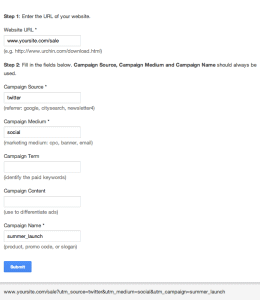

Always use a lowercase version of the domain. Use this to represent where you will be posting the link. Source: This is the place where people are coming from. Here are details on how and when to use each of the three main UTM parameters: In this example, we are using the three main UTM parameters: Source, Medium, and Campaign. You can choose to either fill them all out, or to leave any or all blank. Note: There are five UTM parameters you have to choose from in the Rebrandly UTM Builder.
Utm generator how to#
The following video will walk you through how to use the Rebrandly UTM Builder step by step. Once appended to a URL, the UTM parameters will help you sort out your stats in Google Analytics, or whatever tool you are using to measure your digital marketing and website performance.

Utm generator code#
UTM (Urchin Traffic Monitor) parameters are short snippets of code which are added to the end of a URL to help you track information about where someone came from - the referring domain - and what they clicked on to bring them there.Īdding UTM parameters to the links you share will help you to understand where your traffic is coming from, what messages are working, and tie it to which site visitors are provided the greatest value to your company. It enables you to differentiate between ads or links exposed on the same channel, this can be very useful if you’re A/B testing images or ad copy.This article will teach you how to use the Rebrandly UTM Builder. The campaign content is the most specific of all of the parameters and thus used the least. You can get creative about how to use the term parameter, though it’s generally thought of as a keyword. A couple examples of how a campaign term might be used would be paid keywords or the keyword of a link in a blog post. The campaign term is so specific that it is less commonly used. In a way it’s more specific than the source, tracking the type of creative such as a banner ad, email, or social media post. This is the marketing medium that was presented to the visitor and referred the traffic. Usually, this is the platform or service that was used to create the medium. This is the name of the referrer, like Google, Facebook or another website or service. You can think of it as a group name for a set of tagged URLs and more broadly as a traditional marketing campaign marker. This is generally used to identify a marketing campaign or offering. ( Note: using all of the parameters isn’t required – though the general rule of thumb is that you should use a campaign source at a minimum) Now, let’s dig into all the possible components of UTMs: URL, campaign name, campaign source, campaign medium, campaign term and campaign content. Let’s take a closer look at how a UTM tagged URL is setup. If you’re interested knowing anything more specific like the medium, source, tweet, page or even version of an image or button, you’re out of luck with just a referrer. Without UTMs analytics systems usually still identify the referrer, but this is simply another website or application that users are visiting from. When UTMs are available, certain analytics systems store additional information about a visit which enables you to measure where traffic is coming from.

Utm generator series#
A UTM (Urchin Tracking Module) is essentially a series of parameters that are appended to the end of a URL. If you’re just getting started, you might want to check out this blog post, A Beginner’s Guide to Campaign Tracking with UTM Parameters. Inbound traffic usually has a referrer, but using UTMs gives marketers the flexibility be much more specific and truly understand what is driving engagement. The goal behind UTMs is to enable URLs to carry additional information with inbound traffic. The URL Builder should work for any of the mentioned systems. The Google Analytics URL Builder above generates Google Analytics Tracking Codes that work with Google Analytics, Mixpanel, Kissmetrics and other common analytics platforms.


 0 kommentar(er)
0 kommentar(er)
